 After 2 roller coaster years, I now have an M.B.A. from the NYU Stern School of Business. It feels a bit like a 180, since I assumed a flute performance degree would be my first and final tryst with higher education. Sitting here today, however, the transition from music to marketing feels perfectly organic. My two alma-maters, NEC and NYU, have given me more opportunities than I can count: and they complemented one another in surprising ways. The “return on investment” (we M.B.A’s can’t get enough of this phrase) from NYU includes a better understanding of strategic planning, five trips around the globe, ample space to exercise leadership skills, and a wealth of talented and generous friends. What comes next will be a combination of the exciting and the unknown, and I’m looking forward to the challenge. Not surprisingly, this 2-year degree pushed me to neglect this blog – so now that I have some room to breathe, I am finally back to sharing some of my favorite recipes and music. And to show my renewed commitment, I’ll be sharing four delicious features:
After 2 roller coaster years, I now have an M.B.A. from the NYU Stern School of Business. It feels a bit like a 180, since I assumed a flute performance degree would be my first and final tryst with higher education. Sitting here today, however, the transition from music to marketing feels perfectly organic. My two alma-maters, NEC and NYU, have given me more opportunities than I can count: and they complemented one another in surprising ways. The “return on investment” (we M.B.A’s can’t get enough of this phrase) from NYU includes a better understanding of strategic planning, five trips around the globe, ample space to exercise leadership skills, and a wealth of talented and generous friends. What comes next will be a combination of the exciting and the unknown, and I’m looking forward to the challenge. Not surprisingly, this 2-year degree pushed me to neglect this blog – so now that I have some room to breathe, I am finally back to sharing some of my favorite recipes and music. And to show my renewed commitment, I’ll be sharing four delicious features:
– Apple-Raspberry Crisp with Pecan Crunch Topping
– Coleslaw with Gorgonzola
– Smoky Oven-Roasted Spareribs
– Sour Cream Cornbread
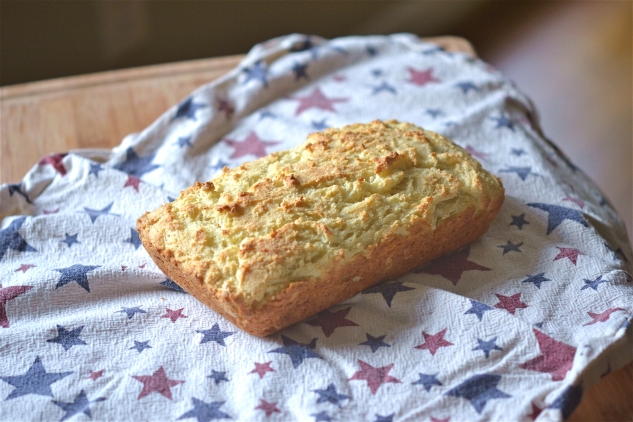 Let’s start with the cornbread: any Southern chef will insist that cast iron and cornbread and inseparable concepts…except when you don’t have one, in which case glass pans are an OK substitute. It worked for us, and was still enjoyed by all our guests (most of whom were Southern). The original recipe calls for a spice that is impossible to find in your local Kroger or Safeway, known as Aleppo. And while nutmeg is a suggested replacement, we just went ahead without – and served the bread warm with lots of butter. Click HERE for the recipe of this baked golden delight.
Let’s start with the cornbread: any Southern chef will insist that cast iron and cornbread and inseparable concepts…except when you don’t have one, in which case glass pans are an OK substitute. It worked for us, and was still enjoyed by all our guests (most of whom were Southern). The original recipe calls for a spice that is impossible to find in your local Kroger or Safeway, known as Aleppo. And while nutmeg is a suggested replacement, we just went ahead without – and served the bread warm with lots of butter. Click HERE for the recipe of this baked golden delight.
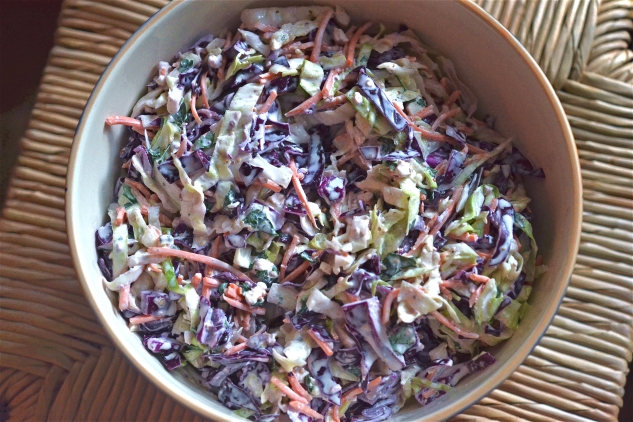 This coleslaw was awesome; like “we ate this for days after” kind of awesome. The original recipe called for Blue cheese, but we bought a tub of Gorgonzola that was on sale. (Thank you grocery gods for introducing us to this better option). We made the coleslaw the day prior, and it’s fairly simple to throw together. Feel free to adjust the dressing to your taste. Click HERE to see the recipe of this easy-to-make side.
This coleslaw was awesome; like “we ate this for days after” kind of awesome. The original recipe called for Blue cheese, but we bought a tub of Gorgonzola that was on sale. (Thank you grocery gods for introducing us to this better option). We made the coleslaw the day prior, and it’s fairly simple to throw together. Feel free to adjust the dressing to your taste. Click HERE to see the recipe of this easy-to-make side.
 And now, les ribs. The spice rub is a medley of things that all look great on paper: paprika, different peppers, cumin, salt, and…mace. (It claims that nutmeg can replace this, but we were super curious to discover what mace would taste like). The recipe makes about 2 cups worth, which is plenty for this recipe and then some. The taste is oddly similar to Old Bay Seasoning: so if you’re not a fan, I’d recommend sticking with good ol’ fashioned BBQ sauce. Fun fact about Old Bay: it is nearly 80 years old, and is believed to have been a clever way crab restauranteurs would push patrons to purchase more beverages (due to its extra “salty” factor).
And now, les ribs. The spice rub is a medley of things that all look great on paper: paprika, different peppers, cumin, salt, and…mace. (It claims that nutmeg can replace this, but we were super curious to discover what mace would taste like). The recipe makes about 2 cups worth, which is plenty for this recipe and then some. The taste is oddly similar to Old Bay Seasoning: so if you’re not a fan, I’d recommend sticking with good ol’ fashioned BBQ sauce. Fun fact about Old Bay: it is nearly 80 years old, and is believed to have been a clever way crab restauranteurs would push patrons to purchase more beverages (due to its extra “salty” factor).
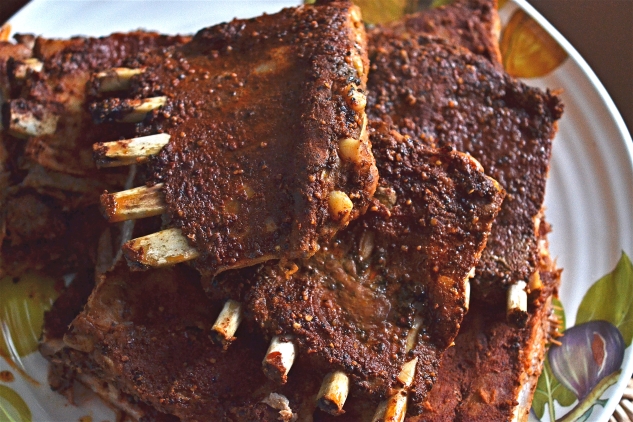 The ribs themselves were roasted in an oven, for 6 wonderful hours at the lowest possible heat. While cooking these on a grill is an option, the oven provides a lower maintenance one that still yields fantastic results. We coated the three racks with the rub, wrapped them tightly in aluminum foil, and then didn’t open the oven door once during the 6-hour haul. The result was fall-off-the-bone ribs with a smoky aroma. How tender, you ask? My stepdad carved these with a butter knife. Click HERE to see the recipe for these irresistible ribs.
The ribs themselves were roasted in an oven, for 6 wonderful hours at the lowest possible heat. While cooking these on a grill is an option, the oven provides a lower maintenance one that still yields fantastic results. We coated the three racks with the rub, wrapped them tightly in aluminum foil, and then didn’t open the oven door once during the 6-hour haul. The result was fall-off-the-bone ribs with a smoky aroma. How tender, you ask? My stepdad carved these with a butter knife. Click HERE to see the recipe for these irresistible ribs.
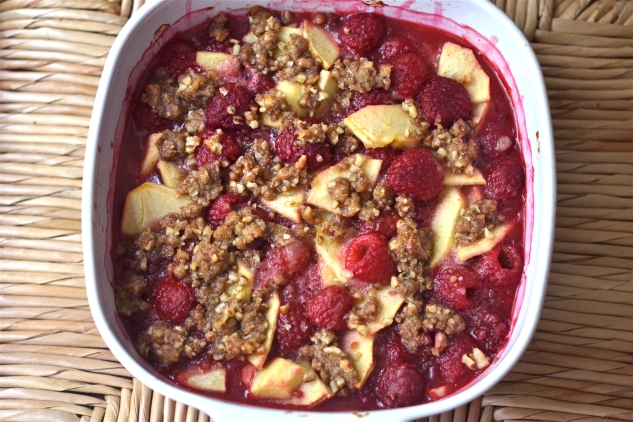 And finally, the dessert: a simple crumble that had all of the things we love about summer: fruit, butter and ice cream. The recipe is simple, and can be assembled the night before – we plopped the crumble into the oven before the guests arrived, and warmed it back up for ~15 minutes at the end of dinner for serving. You can use any combination of fruits in this crumble, just know that some may take a bit longer to cook than others (great example: rhubarb). Click HERE to see the recipe for this colorful treat.
And finally, the dessert: a simple crumble that had all of the things we love about summer: fruit, butter and ice cream. The recipe is simple, and can be assembled the night before – we plopped the crumble into the oven before the guests arrived, and warmed it back up for ~15 minutes at the end of dinner for serving. You can use any combination of fruits in this crumble, just know that some may take a bit longer to cook than others (great example: rhubarb). Click HERE to see the recipe for this colorful treat.
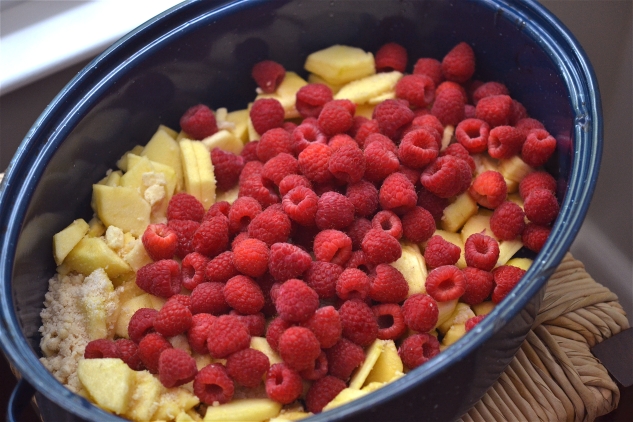 It has been so long since I have paired a piece of classical music with a meal, that I had to invest considerable energy into this final section. So much so that I started drafting this blog over 1 month ago. And then the piece that came to mind was so simple and perfect: Beethoven’s Symphony No. 5 in C minor. It is arguably one of the world’s most famous symphonies, and thus feels like the perfect inflection from my musical roots to a marketing future.
It has been so long since I have paired a piece of classical music with a meal, that I had to invest considerable energy into this final section. So much so that I started drafting this blog over 1 month ago. And then the piece that came to mind was so simple and perfect: Beethoven’s Symphony No. 5 in C minor. It is arguably one of the world’s most famous symphonies, and thus feels like the perfect inflection from my musical roots to a marketing future.
Beethoven began working on the 5th symphony at the age of 33. It would take him 4 years to finish, in the midst of what many consider  to be the most fruitful period of his career. However, Beethoven was also battling the deterioration of his hearing faculties – a development for which he proclaimed “[I must] seize Fate by the throat; it shall not bend or crush me completely.” One of the main characters of this symphony is Fate herself, persistently “knocking” at the door with the ever-recognizable motif (“Da-da-da-dom”), as the symphony opens in an ominous C-minor. Yet Fate is held at bay, with the symphony closing in a triumphant C-Major. This structure, of man versus fate, lent itself to many a narrative, bringing the work and Beethoven to great celebrity over the years. As an example: the piece was used to dramatic effect at the end of World War II to symbolize victory for the allies. And Disney further commemorated the work in the feature film Fantasia 2000.
to be the most fruitful period of his career. However, Beethoven was also battling the deterioration of his hearing faculties – a development for which he proclaimed “[I must] seize Fate by the throat; it shall not bend or crush me completely.” One of the main characters of this symphony is Fate herself, persistently “knocking” at the door with the ever-recognizable motif (“Da-da-da-dom”), as the symphony opens in an ominous C-minor. Yet Fate is held at bay, with the symphony closing in a triumphant C-Major. This structure, of man versus fate, lent itself to many a narrative, bringing the work and Beethoven to great celebrity over the years. As an example: the piece was used to dramatic effect at the end of World War II to symbolize victory for the allies. And Disney further commemorated the work in the feature film Fantasia 2000.
This is perhaps a bit of a cheesy pairing, but the symphony’s resonance beyond classical circles suggests it is an apt one as I start this new chapter in business. The following performance is with the NBC Symphony Orchestra, led by Leonard Bernstein. Enjoy!
Sources Cited:
“Old Bay Seasoning.” Wikipedia.
“Beethoven’s Symphony No. 5 in C Minor, Op. 67”. NPR.


























































